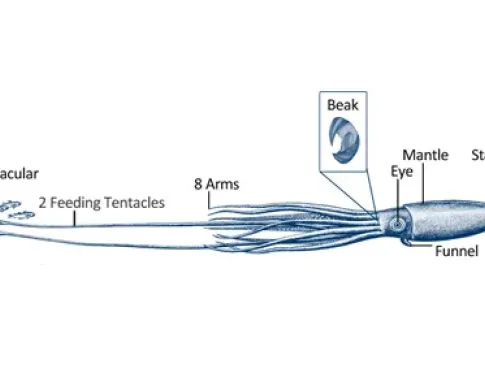Image

Due to the government shutdown, we are temporarily closed. Please check back for reopening updates.

The Smithsonian’s National Museum of Natural History has two giant squids on display, both in the Sant Ocean Hall. There are about a dozen giant squid on display in museums and aquaria around the world, and these are the only ones on display in the United States.
Giant squid live up to their name: the largest giant squid ever recorded by scientists was almost 43 feet (13 meters) long, and may have weighed nearly a ton. You’d think such a huge animal wouldn't be hard to miss. But because the ocean is vast and giant squid live deep underwater, they remain elusive and are rarely seen: most of what we know comes from dead carcasses that floated to the surface and were found by fishermen.

The female (the bigger of the two) was caught in a fisherman’s net off the coast of Spain in 2005. It was probably between 2 and 3 years old and, when alive, 36 feet long with tentacles that extended 22 feet. Since then it has shrunk considerably, but at 25 feet long, it is still an impressive sight.
Transporting the giant squid carcasses from Spain to Washington, D.C. was a noble task. With the help of the U.S. Navy and U.S. Air Force the squids were flown across the world during Operation Calamari. Before transport, the museum needed to design special tanks that could accommodate the squids' size and allow for proper preservation. The tanks hold between 1,500 and 1,800 gallons of fluid, are completely airtight, contain valves and openings for refilling preservative fluid when necessary and taking tissue samples, and are equipped with appropriate gear for anchoring all body parts and tentacles to prevent floating. Since international shipping regulations prohibit transportation of hazardous materials in an airplane, the squids were wrapped carefully in cheesecloth and crated tightly for their trip. Several squid specialists accompanied them on their flight, and as soon as they arrived, they were met by Smithsonian personnel and immediately installed into their new quarters at the ocean hall.
This specimen and the smaller male are on loan to the Smithsonian from the Coordinadora para el Estudio y la Protección de last Especies Marinas, which preserves giant squid specimens from the waters of northern Spain.
The Smithsonian doesn't just house giant squids—scientists at the Smithsonian’s National Museum of Natural History continually add to a National Cephalopod Collection. It already totals about 200,000 preserved specimens collected worldwide—including the most diverse collection of squids found in the world. The museum’s collection also includes the holotypes for 164 cephalopod species, including 66 squid species. Holotypes are the specimens that were used by scientists to formally describe and name a new species.







Find the full Museum map here.